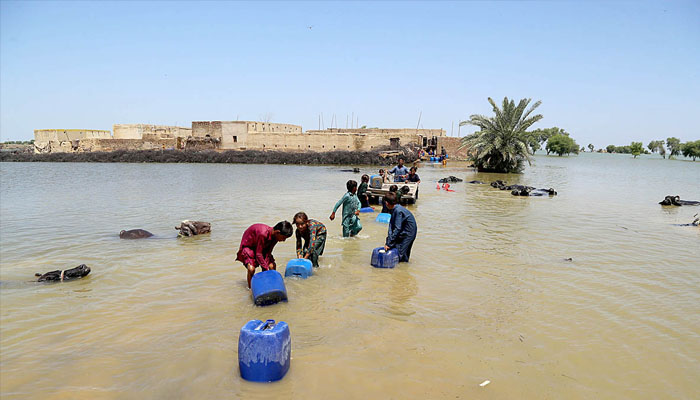Floods destroyed 118 districts, caused Rs2,000bn loss
The inflation is projected to hover around 20 per cent on annual basis
ISLAMABAD: In the wake of severe floods, Pakistan has prepared its preliminary report on losses on the economic front, and assessed that the economic activities faced major damages in 118 districts, and the country suffered an economic loss of over Rs2,000 billion.
The country’s GDP growth has been projected to evaporate by 2 per cent and it will be hovering around 3 per cent, against the initially envisaged growth rate target of 5pc in the budget for financial year 2022-23.
The huge losses on the economic front may aggravate further as the SBP’s model is estimated to ascertain losses on the basis of disrupted economic activities, which hit all districts and tehsils in the flood-affected areas. The SBP has been using satellite images of Suparco to assess the exact losses, faced by the agriculture sector. Google has also offered the Government of Pakistan to get its services to ascertain total accumulated losses to the agricultural and physical infrastructure.
The inflation is projected to hover around 20 per cent on annual basis, but there will be some spike in the coming months on short-term basis. Inflation in August 2022 touched a new height and reached 27.3 per cent, which was 47 years high since 1975. The CPI-based inflation may cross 29 per cent mark in the coming months.
The last flood that hit the country in 2010 had caused damages in 78 districts, but the veracity of recent floods could be gauged from the fact that it had caused damages in 118 districts of those areas which are major hub of economic activities. The government will also make assessment that how much the severe flood has impacted prevalence of poverty and unemployment in Pakistan.
The State Bank of Pakistan was using its model to assess exact damages and found that this time the floods hit those areas of the country which possessed major economic activities. A preliminary assessment on economic losses has been prepared in a high-level meeting, held with Minister of State for Finance Aisha Ghaus Pasha in the chair on Thursday, and participated by representatives of Ministry of Finance, Ministry of Planning, State Bank of Pakistan, FBR and others. It has, so far, been estimated that the country’s Gross Domestic Product (GDP) is projected to evaporate by 2pc and will be standing at 3pc of the GDP against the desired target of 5pc for the current fiscal year 2022-23 in the post-flood scenario. The IMF has recently projected GDP growth rate of 3.5pc. The SBP has been asked to come up with projection of Current Account Deficit (CAD).
The state minister for finance, when contacted, told a select group of reporters that the initial assessment was underway and it would be firmed up soon after which it would be made public. She said that the assessment of damages on the economic front would be shared with the donors. The government has also directed the authorities concerned to come up with the projection of assessment about possible increase in non-performing loans (NPLs).
The government envisaged agriculture growth target of 3.9pc for the current fiscal year. The initial assessment shows that the agriculture growth would face loss of 1.8pc, reducing it to 2 per cent of the GDP. The services sector will face loss of 2pc of GDP and will be standing at 3.1pc of GDP against the envisaged target of 5.1pc for the current fiscal year. The SBP’s chief economist has been playing as catalyst role to assess the losses, but the planning ministry did not play any active role despite the fact that the macroeconomic projection was in fact its domain.
Federal Minister for Finance Miftah Ismail when contacted in his office on Thursday said that the international donors were providing funds off the budget in order to provide relief in flood-hit areas. He said that the government did not contact the IMF so far, but options were under consideration to seek the IMF loan under Large National Disaster Window as the country would be eligible to get 80pc of its quota share. He said that he would contact the IMF formally once the government finalised its exact estimates on the losses, faced by the economy in the aftermath of floods.
Sources said that the Rapid Financing Instrument (RFI) has been another option which can be explored to get financing from the IMF. Pakistan may also seek relaxation on tough structural conditions and benchmarks under the existing Extended Fund Facility (EFF), provided the authorities come up exact losses estimates.
-
 Alexander Skarsgard Breaks Silence On Rumors He Is Bisexual
Alexander Skarsgard Breaks Silence On Rumors He Is Bisexual -
 King Charles Faces Rift With Prince William Over Prince Harry’s Invictus Games
King Charles Faces Rift With Prince William Over Prince Harry’s Invictus Games -
 Elon Musk’s Critique On ChatGPT Safety Draws Sharp Response From Sam Altman
Elon Musk’s Critique On ChatGPT Safety Draws Sharp Response From Sam Altman -
 Katherine Ryan Takes Aim At Brooklyn Beckham In Fierce Defense Of His Parents
Katherine Ryan Takes Aim At Brooklyn Beckham In Fierce Defense Of His Parents -
 How Timothy Busfield, Melissa Gilbert Really Feel After Release From Jail
How Timothy Busfield, Melissa Gilbert Really Feel After Release From Jail -
 OpenAI, Bill Gates Launch ‘Horizon 1000’ To Transform AI Healthcare In Africa
OpenAI, Bill Gates Launch ‘Horizon 1000’ To Transform AI Healthcare In Africa -
 Prince Harry Receives Praises For Exposing Dark Side Of British Tabloids
Prince Harry Receives Praises For Exposing Dark Side Of British Tabloids -
 Andrew Forces Beatrice, Eugenie To Lose $60 Million Safety Net Saved For Retirement
Andrew Forces Beatrice, Eugenie To Lose $60 Million Safety Net Saved For Retirement -
 Nvidia CEO Jensen Huang To Visit China To Push Re-entry Into AI Chip Market
Nvidia CEO Jensen Huang To Visit China To Push Re-entry Into AI Chip Market -
 U.S. On Verge Of Losing Measles-free Title Due To Outbreak
U.S. On Verge Of Losing Measles-free Title Due To Outbreak -
 Harry Styles Excites Fans As He Announces Release Date Of New Song
Harry Styles Excites Fans As He Announces Release Date Of New Song -
 Japan’s Ex-PM Shinzo Abe’s Killer Is Set To Be Sentenced: How Much Punishment Could He Face?
Japan’s Ex-PM Shinzo Abe’s Killer Is Set To Be Sentenced: How Much Punishment Could He Face? -
 Prince Harry, Meghan Markle’s Return To UK Could Create Royal Family Dilemma
Prince Harry, Meghan Markle’s Return To UK Could Create Royal Family Dilemma -
 Prince Harry Turns Troubled With No Sense Of Home: ‘Isolation Is Getting To Him Mentally’
Prince Harry Turns Troubled With No Sense Of Home: ‘Isolation Is Getting To Him Mentally’ -
 Vitamin D Link To Respiratory Diseases Will Shock You
Vitamin D Link To Respiratory Diseases Will Shock You -
 A$AP Rocky Gives His Take On Children's Budding Personalities
A$AP Rocky Gives His Take On Children's Budding Personalities




